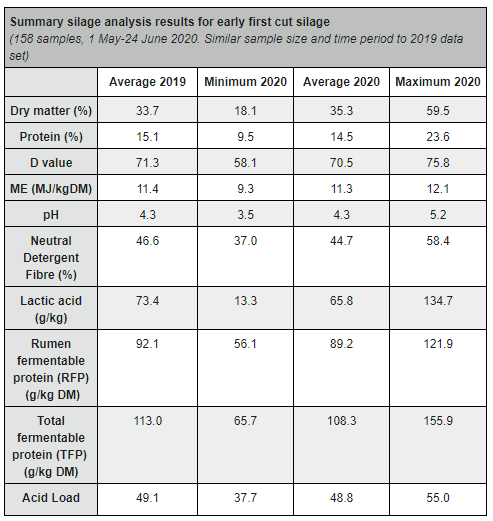



Early first cut brings fermentation and protein concerns
Current analysis of grass silage suggests that farmers will have to carefully consider ration protein levels and secondary fermentation risks this season.Initial trends from a small sample of 158 first cut silage samples analysed by Mole Valley Farmers show that lactic acid levels are lower than might have been expected, which will increase the risk of drier silages heating and dry matter losses.
“The drop in lactic acid is significant,” says Senior Nutritionist for Mole Valley Farmers, Dr Robin Hawkey. “This year’s average is 65.8g/kg - down from 73.4g/kg for the same period last year. And the maximum is 134.7g/kg - that’s down from 153.1g/kg. That drop will increase the risk of secondary fermentation when drier clamps are opened - particularly if this hot weather continues.
“However, it is good news for rumen health and milk butterfats as acid load in the rumen will be reduced.”
To limit secondary fermentation risks when lactic acids are low, Dr Hawkey suggests using a TMR stabiliser product, such as Profresh Plus. This will help prevent mould and mycotoxin growth.
“It’s also worth avoiding leaving mixes in the wagon for long periods or doing a couple of TMR mixes a day to avoid heating,” he adds.
The protein profile of these first cut grass silages also appears to be low, with both crude protein (14.5 percent), rumen fermentable protein (89g/kg DM) and total fermentable protein (108.3g/kg DM), down on last year. This fits with a trend in low protein levels in fresh grass and low milk ureas, which is an indication that cows are experiencing a protein deficit.
To overcome this issue, Dr Hawkey suggests carefully balancing ration protein level, which might include upping the protein level in parlour cake or feeding more of the same protein cake.
Bearing in mind that these initial silage analysis results are from a relatively small sample-set, time will tell as to whether this trend continues. However, If it does, there will be a requirement to increase protein sources this winter to ensure cows receive adequate levels. This could mean balancing with rape or soya, for example.
It could also be worth adding protein to grain or whole-crop cereals by treating them with a urea enzyme treatment, such as Maxammon. Depending on the rate applied, this treatment can raise protein levels by about 4 percent.



